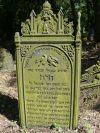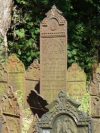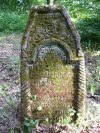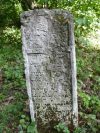| strona główna | cmentarze | warto wiedzieć | księga gości | napisz do nas |
| KRZEPICE | ||||
The first Jewish settlers appeared in Krzepice in the 17th century. There are mentions of them from as early as 1633. Population numbers rose slowly at the beginning of the settlement - in 1720 the Jewish population of Krzepice upon the Liswarta river consisted of merely 4 families. Some time after 1730 the first synagogue was opened. When in 1765 the population of Jews in Krzepice grew to 116, a Jewish neighbourhood was formed outside of the city limits. It got named "The new city of Krzepice" and is today known as Nowokrzepice. The Jewish population's primary occupations were commerce and running inns, but had significant aportations to local art crafts. The number of Jewish inhabitants started growing quickly, and by 1808 it reached 322 people - which constituted 21% of the total population of Krzepice. Shortly after, a second synagogue was built, which started its erection in the years 1814-1815 on a site close to the shores of the Liswarta river (currently Wenecka street). The building was made of solid lime rocks, bricks and stones from closeby fields and measured 24,1 m x 13,6 m. It was built in a neoclassical style. Over the entrance was a stone plaque picturing an open book with two lions holding a braided Star of David. Over the plaque was an inscription in Hebrew which said: "Such yearning this place gloats. Nothing here but the house of G-d and the gates to heaven". Next to the synagogue there was a Jewish school, and not far were a mikvah and the rabbi's house. In 1822 the Krzepica Jewish community emancipated itself from the larger Dzialoszyn community. |
||||
The number of Jews in Krzepnica gradually grew. In 1847 the population counted 1054 - nearly half of the overal population of Krzepice. In 1880 the number grew to 1456, in 1908 to 1700 , and by 1931 it had decreased to 1636. At that time there were two synagogues and four prayer houses in the city. On the 27 October 1936, the representatives of Jewish guilds formed the General Jewish Craftsmen Guild of Krzepice ond the area. The beginning of WWII meant the gradual anihilation of the Jews from Krzepice. In 1939 the older synagogue got damaged by a bomb, which susequentially lead to its total removal. The year after deportation of young people of Jewish origin to labour camps started. In 1941 the occupants formed an open Jewish ghetto (on the streets Rebielska, Krakowska, Solna and Dzielna) where a Council of Elders was formed, and the Jewish police were in charge of keeping the order. In June and July of 1942 the Germans sent the entire population in two groups to death to Auschwitz-Birkenau. After the war a few Jews returned to Krzepice. Amongst them were Rozyn Szlama and his wife Ruhla, Haim and Ruhla Moszkowicz, Dawid Korek, and Józef Judek (who later changed his surname to a more Polish-sounding Judkowski). However, the Jewish population once again left due to the March of 1968 situation. The last Jew from Krzepice - Mr. Józef Judkowski died in 1993, putting an end to Jewish life in this city. All that now remains is a deterriorating synagogue with cracked walls and a Jewish cemetery. |
||||
 |
 |
 |
 |
 |
The Jewish cemetery in Krzepice was created at the turn of the century, between XVII and XVIII centuries. It is situated aproximately 700m from the synagogue in Nowokrzepice and aproximately 150 m from the Liswarta river (although the river once ran closely to it). The surface of the cemetery is 1,1 ha, and was once compound from the north, east and south by a wall of solid lime rocks, and by a wooden fence from the west. Today only remains from this compund are left. Not far from the western cemetery border are now rail tracks. Some time in the past the entrance path was adorned with a magnificent gate reminiscent of a barn. It was 5 meters long and lead 3 meters into the cemetery. The oldest remaining tombstone dates back to 1740, and the last one is from 1946. The majority of inscriptions on the tomstones are in Hebrew, however there is one with inscriptions in Polish and it belongs to Ryfka Cyncynatus who lived between 1864 and 1937. |
||||
 |
 |
 |
 |
 |
The Krzepice cemetery is unique. It is one of the largest collections of cast iron matzevas in Europe, counting more than 400 of these. The majority of the Krzepice matzevas was produced in the steelwork of Stara Kuznica, which was in Jewish hands for some period of time in the XIX century. Unfortunately after the war this cemetery was completely devastated, with cases of some cast iron matzevas being sold as scrap metal. In 1997 the first attempt of restoration the cemetery was taken the Polish Union of Jewish Students and Jan Jagielski from the Jewish Historical Institute. They removed weeds and rose some knocked tombstones. According to an inventory from 1997, the number of surviving gravestones is 244 stone matzevas, 66 matzevas made from stone objects like columns, and 402 cast iron matzevas. In 2000 due to an initiative of students from local and Warsaw schools, along with pupils from a special school in Borzecziczki led by Jerzy Fornalik, major restoration works started. They rose, cleaned and dug out tombstones (more on this initiative at www.antyschematy.com) Almost all of the remaining cast iron matzevas have been restored and painted with anticorrosive coating. Thanks to these young people we can now appreciate the cemetery in all its glory.
|
||||
Jewish cemetery in Krzepice (photos by Michał Traczyk) |
||||
 |
 |
 |
 |
 |
| Go to Zbigniew Bogatko's photo gallery to watch more pictures from this cemetery. | ||||
| strona główna | cmentarze | warto wiedzieć | księga gości | napisz do nas |

